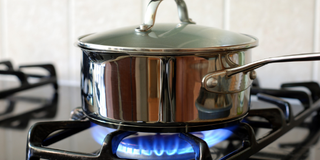Tanzania domestic gas puzzle

What you need to know:
Consumption of kerosene during the period jumped to 54.8 million liters from 43.5 million liters, with Energy and Water Utilities Authority (Ewura) linking an increase to the rising cost of charcoal and scarcity of firewood especially in cities and townships.
Dar es Salaam. Import of Liquefied Petroleum Products (LPG) into the country increased by half in 2016/17 financial year, signaling that Tanzania is making progress in providing modern and clean energy for all its citizens.
But even with the increase in consumption of LPG by 50 per cent to107, 083 metric tonnes, the majority of people still use traditional biomass for cooking, suggesting there is still a long way to go, if the government is to end tree felling.
Going by the 2016 Energy Access Situation Report (EASR), 71.2 per cent of households in the country use firewood.
Apart from a high rate of firewood consumption, some people still are in favor of consumption of kerosene, according to Ewura report.
Its use In 2016/17 financial year went high by 26 per cent.
Consumption of kerosene during the period jumped to 54.8 million liters from 43.5 million liters, with Energy and Water Utilities Authority (Ewura) linking an increase to the rising cost of charcoal and scarcity of firewood especially in cities and townships.
Perhaps the high costs of charcoal would be a relief to environment conservation, according to the Tanzania Forestry Services (TFS) chief executive, Prof Dos Santos Silayo.
“Basing on the past experience, as the wealth of the households increases the households were switching from using firewood to charcoal, which was still a detrimental to environments,” he told The Citizen’s sister newspaper Mwananchi.
LPG is the primarily considered to be used by those classified as the richest households.
The report shows the number of households using cooking gas stood at 7.2 in 2016.
A total of 107,083 metric tonnes of LPG was imported into the country by LPG Marketing Companies (LMCs) in 2016/17 as compared to 71,311 metric tonnes imported in the last financial year.
A Significant increase of LPG imports during the period under review may be attributed to continued initiatives by Ewura through increased awareness campaigns on the use of LPG, as well as improved marketing strategies by LMC’S.
However, such increase has been outmatched by economic hardships and increased competition, according to cooking gas sellers.
Low consumption
The Citizen has leant that many are yet to be reached with cooking gas due to financial constraints.
Ms Mariam Tuya, a resident of Gongolamboto, says gas is more effective in terms of time but due to financial muscle problems she is forced to use both gas and charcoal.
“Since the price of gas has gone high, I have no choice than mixing the two sources of energy. It is difficult for me to get Sh19, 500 at once for refilling my six-kilo gas cylinder,” she says.
She spends an average of Sh19, 500 for gas and Sh15, 000 for charcoal every month.
She was echoed by Ms Rebecca Gideon, a resident of River Side, in the city, on the grounds that she only uses gas for cooking light food.
Poor business performance
A cooking gas seller at Tabata, Mawenzi Samuel Nyoso said despite an increase in importation of LPG, the price of gas cylinders have gone high, lowering its demand.
Currently, according to The Citizen survey, the price for the 15- kilo filled cylinder stands at Sh49, 000, well above the previous year’s Sh45, 000.
To buy a six-kilo its costs one Sh19, 000 from last year’s Sh18, 000.
As a result, his sales, according to him, has decreased to an average of two gas cylinders per week, well below the last year’s seven, with six-kilo cylinder accounting for the highest portion of sales due to relative low price.
“The business is not on our side despite increased importation of LPG. This is due to unaffordability of the product due to economic hardships,” Mr Nyoso told The Citizen.
This is not a good thing to environments as it may force people opt for other sources of energy like firewood and charcoal which are disastrous to environment.
Petroleum Bulk Procurement Agency (PBPA) acting director general Erasto Simon says lack of bulk procurement system is to blame for higher prices of cooking gas.
As it happens, importers of LPG have not started procuring the product using bulky system due to shortage of storage facilities to accommodate bulky stock, according to him.
“With lack of procurement agency, it is hard for Ewura to monitor the prices of cooking gas because there is no uniformity in importation costs partly because Local Marketing Companies are importing it on individual basis,” said Mr Simon.
He says, it will not take long before the use of system was put in place as some large investors; Mihan and Oryx, have started expansion of their storage facilities.
Ewura public relations manager Titus Kaguo attributes high price of cooking gas to increased prices of petrol.
“Cooking gas prices has a direct proportional with the price of byproduct of crude oil,” noted Mr Kaguo.
“The current prices are reasonable. With the current price of petrol, the price of cooking gas could have been even higher than the current one.”
In between July 2016 and June 2017, average pump prices in Dar es Salaam was Sh1, 938 per liter,
For July 2018, retail price of Petrol imported in the country through Dar es Salaam port increased by 5.53 per cent to Sh2, 409 per liter compared to the previous month’s price.
The increase in local prices is largely attributed to continued increase in the world oil market prices.
Responding to a question on when Ewura would set a price cap for cooking gas, Mr Kaguo said, they were waiting until the market was saturated.
“There are ongoing arrangements for Ewura to start regulating cooking gas prices. However it is somewhat difficult to start doing so immediately due to the fact that its demand is still relatively low,” noted Mr Kaguo.
To overcome the affordability barrier
Mr Kaguo called on distributers to design more low -weight gas cylinders that could be affordable to majority.
Sharing his sentiment, the economists, Dr Abel Kinyondo, who also doubles as Repoa strategic research director, sees a need to subsidize LPG cooking gas to lower their prices.
“Recognition of the importance of access to clean energy is not enough; we must take action in making them affordable by almost people from all walks of life,” noted Dr Kinyondo.
He was seconded by Tanzania Private Sector Foundation (TPSF) executive director Godfrey Simbeye, who calls on LPG distributors to be innovative enough to transform low-income consumers purchase and pay for cooking fuel.
They should think, he opines, of providing energy services on a pay-as-you-go basis.
“In doing so enterprises are leveraging technology-focused business models to overcome the affordability barrier faced by consumers who are unable to afford the upfront cost of household energy products,” noted Mr Simbeye.
However, he said, affordability is not the only reason why it has proved difficult to make progress, putting blame on cultural factor such as a preference for the taste of food cooked in traditional ways.
“Many households do not have access to alternative fuels, like electricity or LPG. Even when they do, they may not use them, or they may continue to use biomass alongside the alternative,” Said Mr Simbeye.
Going by Energy Access Outlook 2017 report, LPG cylinders cost money: solid biomass is often free, except for the time spent gathering it.
Adding that women in particular often earn money to support their households by selling collected solid biomass.
Furthermore, families may not take into account the opportunity cost of time spent gathering fuelwood, especially when fuelwood is a free resource and economic opportunities are scarce.
“When taking into account the opportunity cost of gathering fuelwood, clean cooking facilities may present an overall saving compared with cooking with traditional stoves,” reads a report in part.




